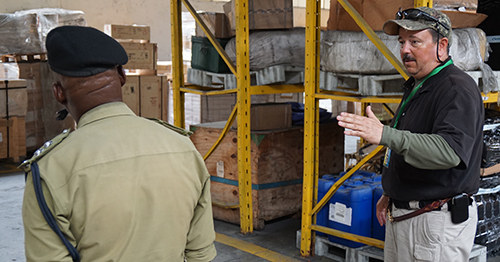
Fighting the Ivory Trade

There’s a wildlife crisis in Tanzania.
Poachers have killed 60 percent of Tanzania’s prized elephants for their ivory tusks, reducing the animals from an estimated 109,000 in 2009 to 43,000 in 2014.
"Those numbers are just devastating," said Chargé d’Affaires Virginia Blaser at the U.S. Embassy in Dar es Salaam. "You can easily see a scenario where they’ll be no elephants in Tanzania."
China is the world’s biggest peddler, fueling at least 70 percent of the illicit ivory trade, followed by the Philippines and Thailand where status and money drive demand, a British Broadcasting Corporation report found.
In those and other nations, ivory is a way to flaunt social rank and wealth by owning jewelry, ornaments and exquisite sculptures fashioned from ivory. Chinese medicine also touts ground ivory for curing everything from epilepsy to sore throats.
Staggering black market prices in Asia for the white gold entices poachers. Ivory can fetch up to $1,500 per pound and two male elephant tusks can weigh 250 pounds, according to an account in British news magazine, The Week.
In their pursuit of wealth, poachers can be ruthless. In June 2016, they shot down a surveillance helicopter with AK-47 assault rifles in Northern Tanzania, killing the pilot. Poachers not only put elephants at risk, they harm Tanzania’s economy with increased crime that discourages wildlife tourism, a major source of that nation’s foreign exchange.
CBP Steps Up
Working on behalf of the Tanzanian government, the U.S. Embassy in Dar es Salaam reached out to former Commissioner R. Gil Kerlikowske for assistance in developing that country’s canine program, particularly how to train their dogs to detect ivory. As a result, CBP’s highly experienced canine handlers were tasked to work with Tanzanian law enforcement to combat wildlife trafficking. This wasn't the first time CBP instructors offered international assistance. They’ve provided training for at least 54 countries.
Assistance began when Damian Montes, director of CBP’s canine program in El Paso, Texas, and Timothy Spittler, CBP’s assistant canine director from Front Royal, Virginia, spent a week evaluating Tanzania’s canine program that maintains about 45 working dogs to see where improvements were needed.
Montes and Spittler found shortcomings in the program. "There was no mentor opportunity," Montes said. "And the handlers needed to better understand how environmental factors such as weather and kennel conditions affect canine ability, as well as proper grooming techniques and how to train handlers in problem solving."
International Effort
From their findings, Montes and Spittler crafted a plan tailored to strengthen the nation’s canine program which offers Tanzanian police the most effective ways to train, maintain and use dogs to locate ivory, heroin and cocaine. Elevating Tanzania’s program to where Tanzanian police accomplish these tasks without assistance is the ultimate goal.
Establishing the program wasn’t easy. The U.S. Embassy coordinated a government-wide effort that included the U.S. Agency for International Development, the Department of Defense and the U.S. Fish and Wildlife Service. Basics, such as potable water, kennels, retrofitting vehicles to transport canines, and fuel were needed along with support from the Tanzanian government and non-governmental organizations.
"We built an entire logistics, training, delivery and operational element that required resources guaranteed by multiple agencies and country support," Montes explained. "We had phenomenal support from Tanzanian law enforcement." Key Tanzanian government officials backed the program and divisions of Tanzanian law enforcement collaborated and shared resources.
CBP’s instructors encouraged Tanzanian law enforcement to network across offices and agencies to overcome some long-standing bureaucratic hurdles that hindered collaboration and sharing resources. "The value of using in-person visits and casual conversations to build cross-organizational relationships and trust is important," said Ron Reichel, who served an 18-month detail in CBP International Affairs as acting director of the Africa Division.

customs inspector through a canine exercise. Photo by Tim Ryan
Training Begins
When the program launched in May 2015, Tanzania selected four of its most promising police officers for training in El Paso.
Belgian malinois, which resemble German shepherds, were selected for the job because the breed withstands heat and adapts to rough terrain, "the optimal dog to be deployed in Africa," said instructor and course developer Benjamin Gutierrez.
For 30 days Gutierrez and Hopper drilled the Tanzanian officers in how to train canines. It was also the first time CBP trained dogs to detect ivory. Not surprisingly, teaching animals to sniff ivory requires ivory, so the instructors obtained a 4-foot tusk and some crushed ivory seized by the U.S. Department of Fish and Wildlife Service.
Training emphasized skills needed in Tanzania because the officers would be on their own when they returned. Tanzania has few veterinarians so they learned first aid for dogs and other medical care. They also learned how to command the canines to search and recognize the scents of drugs and ivory. Teaching canines how to examine containers, luggage and other objects was stressed since the officers will work at both Tanzania’s seaport and airport, Hopper said.
Enforcing Tanzania’s poaching ban, gathering intelligence and building confidence were also part of the plan.
"It’s truly been an honor to be part of their instructor cadre," Gutierrez said, noting how he became close to the Tanzanian officers during that time, learning about their families and personal concerns. "We started as strangers and have become family."

Photo by Tim Ryan
The Celebration
When the officers returned home, the four trained canines were officially presented to the Tanzanian government in a stately ceremony officiated by Jumanne Maghembe, the minister of Natural Resources and Tourism.
Officials and guests sat under a blue tent on seats fitted with white satin covers as handlers guided the dogs, one at a time, along a green carpet runway in a show of prowess. Several boxes were spread out along the lane, one containing simulated contraband.
Tugging hard on their leashes, the malinois rushed forward. They probed. They pried. They panted. They darted between, around and on top of every box, sniffing ceaselessly with upturned noses. A narrator sounding more like a sports announcer, explained each move.
Suddenly, the canine’s gusto ceased and it quickly sat next to a box.
The officer reached into the container and held up the prize, about a foot-long white plastic pipe. The spectators applauded.
From his podium on the other side of the runway, Maghembe addressed the visitors and CBP’s trainers and officials. "We deeply appreciate efforts that the U.S. government is taking to cooperate with our government to ensure the survival of these big wildlife populations," he said.
While noting poachers have taken a toll on Tanzania’s wildlife, the minister predicted the hunted animals will rebound with the international support.
The plan calls for two of the officers to return to El Paso for instructor training and Spittler and Montes to return to Africa to assess the program’s progress. Understanding proper canine care and training along with building a cadre of instructors who can teach these skills is the goal. Success is when Tanzanian law enforcement can independently manage these objectives, Spittler explained.
For the officers, their canines became more friends than working animals. "The four Tanzanian handlers were so excited to see the dogs again after the training in Texas," recalled Chargé Blaser. "The security of the program rests with the relationship those police officers have with their canine partners. That’s what CBP helps them to realize."


CBP's Canine Handlers Benefit from a Rich History
By Paul Koscak
Back in 1969, using dogs to combat drug smuggling was just a novel idea that led to the U.S. Customs Service detector dog program, launched by military handlers at Lackland Air Force Base, Texas.
In 1974, the operation moved to Front Royal, Virginia, on 300 acres of a former cattle research facility. When Congress approved funding in 1991, the facility grew to 100 kennels with an academic building and canines were prepared not only to detect narcotics, but also currency, firearms and explosives.
Alarmed at the increase in illegal alien apprehensions and narcotics seizures, the U.S. Border Patrol launched a canine program in 1986 and later opened a training center in El Paso, Texas. During the first five months of 1987, four canine teams accounted for numerous arrests of concealed people and over $150,000,000 in seized drugs. By 1993, the Border Patrol had 152 canine teams and the training center began instructor and handler classes.
When the Department of Homeland Security formed in 2003, the canine programs of the combined agencies were made into one standard curriculum, directed by the newly formed U.S. Customs and Border Protection. In 2009, the El Paso and Front Royal training centers were merged into CBP’s canine program, with headquarters in El Paso.
Today’s CBP canine program continues to put dogs to the test. Canine college starts immediately after the animals arrive at El Paso or Front Royal and not all of them pass.
"We first check for their drive, sociability, character traits and confidence—their general genetic makeup," to learn what dogs are fit for the field, said Instructor James Hopper. Tests include retrieving, tolerating gunfire or being able to walk on a slick floor. "If they can’t, they may not be able to do a search."
Vendors supply training center dogs, delivering at times up to 10 animals at once, but only canines that make the grade are purchased. The other source is in-house. CBP mates robust dogs to breed puppies, which undergo the same screening. "CBP primarily uses sport and working breeds like malinois, shepherds and retrievers, but we are not breed specific and will take most dogs that pass the selection process," Hopper said. "Sometimes they all pass or just one passes." The successful canines must finally pass a medical check before pretraining begins, he said.
Pretraining lasts five weeks and focuses on detection. Dogs walk through buildings and warehouses, learn to recognize orders and are exposed to field conditions such as noise and distractions. There’s extensive training in finding contraband hidden in vehicles for canines assigned to points of entry. Other dogs are exposed to underbrush and open land to work at Border Patrol checkpoints.
After pretraining, canines move to the field where training continues and they bond with their handlers. CBP’s canine program is continuous and popular. Handlers are selected by their component, then spend seven weeks either in Front Royal or El Paso learning the trade. Classes can be large—up to 40—and extra seats are quickly snapped up by other law enforcers and agencies—sheriffs or local and state police. Recently, the Pennsylvania Department of Corrections and the U.S. Bureau of Land Management participated. The centers also train handlers to become instructors who then return to their component to maintain the canine teams in the field, said Assistant Canine Director Timothy Spittler.
Working with dogs for almost 40 years, Spittler knows what it takes to run a winning program and how CBP stacks up with other canine training facilities.
"By far, none compare," he declared. "There’s nothing operating to our standards. Our program and certification is the benchmark."


